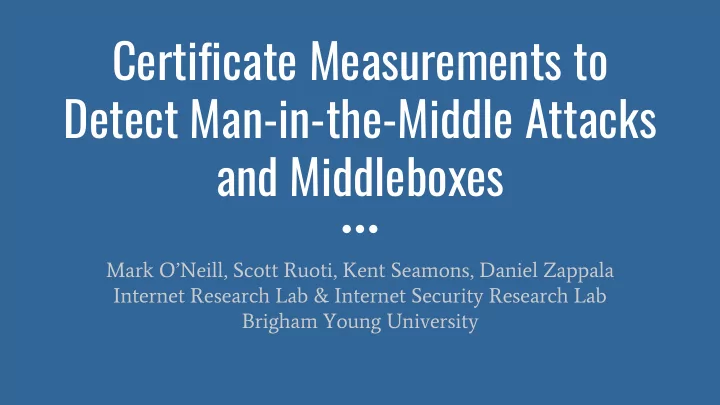

Certificate Measurements to Detect Man-in-the-Middle Attacks and Middleboxes Mark O’Neill, Scott Ruoti, Kent Seamons, Daniel Zappala Internet Research Lab & Internet Security Research Lab Brigham Young University
Certificate validation
Man-in-the-middle attack
Middlebox
How do they fool you? Add a new root cert to your system ● A company may... ● ○ Use private PKI infrastructure Deploy a software image with new root certs ○ A government may... ● Find a CA willing to delegate signing authority to them ○ ○ Own a CA Coerce a company into signing a fake cert ○ A hacker may... ● Break into a CA and issue fake certs ○ ○ Use malware to install a fake cert
How can we measure this? Own a major web site, give Flash detection tool to your users ● Detect proxied connections to Facebook (millions) ○ ○ Prevalence is 1/500, possibly missing those proxies that whitelist Facebook Find some malware, based on self-identification in Issuer field ○ L.-S. Huang, A. Rice, E. Ellingsen, and C. Jackson. Analyzing forged ssl certificates in the wild. IEEE Symposium on Security and Privacy, 2014. Ask mobile users to install an app: Netalyzer ● Prevalence is 1/1500, much smaller sample size (100s/1000s), requires opt in ○ No malware (yet) ○ N. Vallina-Rodriguez, J. Amann, C. Kreibich, N. Weaver, and V. Paxson. A tangled mass: The android root certificate stores. 10th ACM International on Conference on emerging Networking Experiments and Technologies, pages 141–148. ACM, 2014.
How can we measure this? Use Google Adwords to deliver Flash detection tool to users ● Detect proxied connections to 17 sites (millions) ○ ○ Prevalence is 1/250, varies by country Find some additional malware (8%), self-identified in Issuer field ○ M. O’Neill, S. Ruoti, K. Seamons, D. Zappala. TLS Proxies: Friend or Foe? Internet Measurement Conference, 2016 Observe traffic at major sites, fingerprint clients, identify middleboxes ● Measure at Firefox update servers, Cloudflare, popular e-commerce sites ○ ○ Prevalence is 1/25 to 1/10, malware is 1% Lots of broken middleboxes ○ Z. Durumeric, Z. Ma, D. Springall, R. Barnes, N. Sullivan, E. Bursztein, M. Bailey, J. A. Halderman, V. Paxson. The Security Impact of HTTPS Interception, NDSS 2017
Classification of claimed Issuer Organization Based on self-reporting of ● Issuer Organization field Majority are business or ● personal firewalls (84%) 8% malware ● 7% unknown (null) ●
Adware and malware Sendori: compromises ● DNS lookup WebMakerPlus: inserts ads ● in encrypted pages Sweesh, AtomPark: spam ● IopFailZeroAcccessCreate: ● malware Typically add a root cert to ● avoid browser warnings
Negligent Behavior One in parental filter (Kurupira) replaced our untrusted certificate for ● google.com and gmail.com with a trusted certificate signed by its own root cert Allows transparent man-in-the-middle attacks ○ Over half of substitute certificates have weak keys (1024 or 512 bits) ● A small percent use MD5 for signing ● A small percent claim to be signed by Digicert, though none actually are ● A small percent modify the subject field ●
Proxied connections by country Highest = 12% proxy rate, Lowest = 0%
User attitudes survey: scenarios
Strong opinions on notification and consent “If I encrypt something no one has the right to unencrypt it unless I give them the right to - simple as that.”
Now what? Flash measurements no longer feasible ● Going away, no longer accept ads with active probing ○ Server-side measurements ● How do we get enough measurement locations? ○ Attackers can mimic browser or AV fingerprints — miss the attack ○ Client-side measurements ● ○ How do we get certs that user devices (including mobile) actually see? Attackers can masquerade as AV program in Issuer field — but at least see ○ the attack How can we measure this at scale? ○
Recommend
More recommend